|
Saturday, April
16th
|
I leave
Aarhus on the super comfy ICE-train for Berlin at 7.56. The trip down is on 1’st
class, because it was almost as cheap as 2’nd. The train is a direct Berlin
train, so it’s very easy.
I arrive at
Berlin Hauptbahnhof at 2.30. Then it’s a short S-bahn ride to Friedrichsstrasse.
Then a short walk to Hotel Maritim ProArte booked through Priceline.com. Room
238 is very nice.
I check in
and pack out, and then it’s time for my first spaziergang. First I walk to
Oranienburger Strasse. There is an alternative culture house called Tacheles.
It’s threatened with closure. A bank is going to buy it. This calls for a
demonstration. There is one today. I sign to make sure Tacheles will stay alive. |
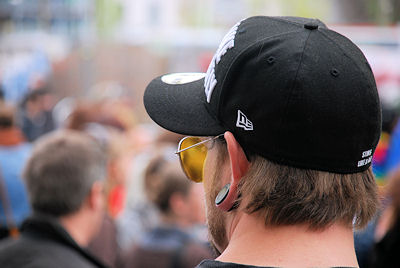 |
 |
I continue
down Oranienburger Strasse. There is no McDonald. If there were, I would walk in
and ask for an Oranienburger. I’m heading for Alexanderplatz. It’s an ugly
place, but you have to take a look at the local TV-tower. But you have to wait
for an hour to get up there. I don’t want to wait that long.
Instead I
head for Mitte again. I pass a funny little DDR-museum, full of old stuff from
the DDR days. Among them is a picture of one of my favorites. Jürgen Sparwasser.
Footballer. Scored for DDR against West Germany in world cup 1974. DDR won by 1
to 0. Then I cross Museumsinsel, and walk down Unter den Linden. There is road
construction all over. I reach my hotel. There’s a specialty at the hotel. You
can hear the TV-sound on loudspeakers at the bathroom. It’s kind of disturbing
when the Snooker-audience at Eurosport suddenly applause. |
The hotel is
very central. In the evening there’s a short walk to Brandenburger Tor and
Reichstag. Maybe you can have a Brandenburger at McDonalds?
Photostory - day 1
Sunday,
April 17th
|
I start the
day with a trip to Prenzlauer Berg. It used to be a neighborhood with low
status. It’s not so anymore. Now it’s very trendy. I get off the U-bahn at
Senefelderplatz, and then take a walk through the area, with nice houses and
plenty of Café’s. And then there’s the old water tower called Fat Herman. Now
it’s been made into apartments and looks very cozy. It wasn’t as cozy during WW2
where Hitler used the place as a KZ-camp.
The walk
around Prenzlauer Berg ends at Mauerpark. There are lots of people here on a
Sunday. There’s a flea market up here, which attract a lot of people. You can
also watch the remains of some of the Berlin Wall painted with graffiti, or hang
out in the park listening to a terrible folk-singer, drinking beer or smoking
pot. From here I continue down Bernauer Strasse, where there are more remains of
the wall, and also a tiny wall-museum. It’s been a long walk so I catch the
S-bahn at Nordbahnhof and returns to the hotel. |
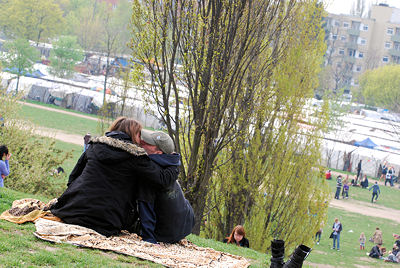 |
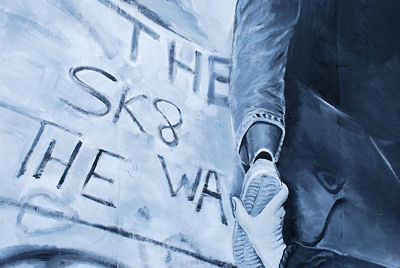 |
At
the hotel I take a well deserved nap, before I head out again. This time
with the S-bahn to Ostbahnhof. Here are more remains of the wall. It’s a
long stretch called the East Side Gallery. Professional artists have
painted this part, and it’s very nice done. At the end I cross the
bridge called Oberbaumbrucke. There is a U-bahn station on the other
side of the river, and a train to take me back.
My
evening stroll is up and down Friedrichsstrasse. That’s one of Berlin’s
major shopping-streets, but on a Sunday night, there is no shopping, so
it’s ok for me. I turn around at Checkpoint Charlie. |
Photostory - day 2
Monday,
April 18th
|
The first
trip today is off the beaten track. I take the S-bahn to Treptower Park, in the
southern outskirts of Berlin. Here is a nice park down to the river Spree, but
that’s not why I’m here. I’m here to see a special park – or exhibition if you
prefer – with monuments back from the Soviet days. In one end of the park
there’s a mausoleum, with a Soviet soldier on the top holding a child in one
hand and a sword in the other. Then there are a number of monuments showing
soldiers and citizens doing heroic things. On the side there are quotes by Josef
Stalin. At the other end there’s a huge monument in red granite, with 2 soldiers
kneeling. The place is pretty vulgar, and it’s hard to imagine that this was
part of daily life here about 22 years ago. |
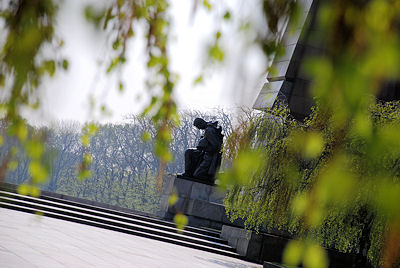 |
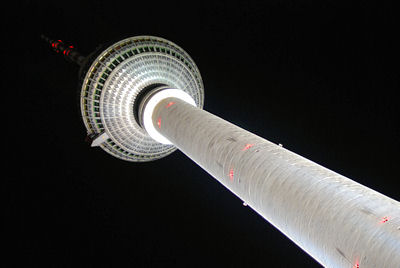 |
From
here I head back for my afternoon-break, before something completely
different. A trip to the Zoo. Knut is not among us anymore, but a Zoo is
always nice with ice-bears, giraffes, penguins and many other different
animals. I stroll around for a few hours taking pictures of strange
animals.
Then
I head on for the KaDeWe, a shopping-place recommended to me. I take the
escalators up and down to 7’Th floor, wondering why this was
recommended. This always happens at shopping-malls for me. But outside
there’s a nice Imbiss with a good Curry-wurst. Then I take the U-bahn
and S-bahn back home.
The
evening trip is to Alexander-platz. I have to go up that tower. It’s
damn expensive, the wait is long and the views are pretty crap. An
excellent tourist-trap. |
Photostory - day 3
Tuesday,
April 19th
|
Berlin has
had its share of essential historical events. 2 of them are on the program for
today.
First I take
the U-bahn down to Kochstrasse. From here there’s a short walk to The Jewish
Museum. There are 2 things that make this museum interesting. The first one is
the building. The architect is Daniel Lieberkind. He has made a building with
strange lines. There are no “normal” rectangular rooms or straight hallways.
It’s all going zigzag – including the windows. That is probably part of the idea
of the museum. The other is the exhibition itself. It tells the story of 2000
years of Jewish living in Berlin. It’s not just about WW2 and the terrible
things that happened then. There is so much information – so many stories, so
many pictures, so many things – that I can hardly cope with all of it. I get
over fed with information, which unfortunately happens way to often for me at
museums.
|
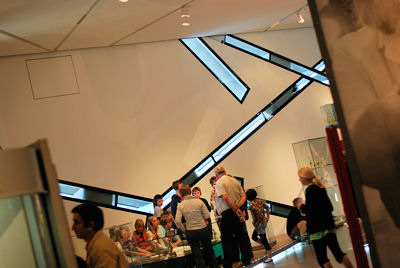 |
 |
Back to the
hotel for a break, before another historic part of Berlin life is taken on. I
take the S-bahn and Tram to the old Stasi-prison at Hohenschönhausen. If you
look at an old Berlin-map there is nothing here. But there is. There is a prison
where they held political prisoners for interrogation. Afterwards they were sent
to real prisons. A guide shows us around the place, which is made out of 2
separate parts. The old one used right after WW2, and a new one built later. The
guide talks about the physical and especial mental torture that was used, to
make the “prisoners” confess. And it all happened not many years ago. For
instance – the Doctor, who “took care” of the prisoners, still have his praxis
just on the other side of the road. And if you were a prisoner, chances are that
you still meet your guard as a police-officer in the German police. It’s a very
exiting place to visit. |
Back to the
hotel via Alexanderplatz. A little shopping at the elecronic-shop called Saturn,
which is all over Germany. Not recommended, but much more useful than KaDeWe.
In the
evening I sit back and relax at the hotel.
Photostory - day 4
Wednesday, April 20th
|
Spaziergang
Nummer Eins is along Karl Marx Allee. This is old eastern European architecture,
with apartments build like a pie. The trip out there is with the S-bahn and
U-bahn to Frankfurter Tor. Here the old workers- and farmers republic build some
huge houses. This was no place for workers or farmers. This was the place for
the Party top and their henchmen. This is the way it looks all along Karl Marx
Allee. To make sure things wasn’t to tight the build the Allee 90 meters wide.
Then there was room for some nice military parades as well.
There is a
special museum out there that I check out. Computerspielmuseum with old
computers and games. I really need to test my skills in Space Invaders. |
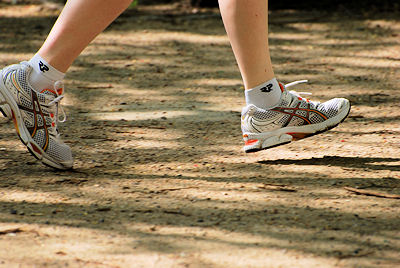 |
 |
From here I
head back to the hotel.
Spaziergang
nummer Zwei start at Kochstrasse and head over to the museum called Topographie
des Terrors. It’s located where SS and Gestapo had its head-quarters. It’s a
very seriously place. They use a lot of photos to tell the story. This area of
Mitte is strong in history. There is a short walk to Potsdammer Platz – no-mans
land during the cold war – but not turned into a glass and steel complex with
shops and offices.
A little
north is Holocaust Memorial. That’s a memorial for the many Jews that were
killed during WW2. There is 2711 sarcophagi made of cement, which rises from the
ground. I don’t count, but I trust my guide-book
From here I
return to the hotel, where I spend the rest of the day – relaxing. |
Photostory - day 5
Thursday,
April 21st
|
I wake up
late today. When I finally get up, and have done my morning breakfast ritual at
Starbucks cross the road, its time for another museum. This one is The Ritter
Sport Museum close to Gendarmenmarkt. Finally a museum I can cope with – this is
not too big. Takes five minutes to cover it all. Some would call it a
chocolate-shop, but who cares.
Then I
continue to Gendarmenmarkt to take a look at the 2 churches Französischer Dom
and Deutscher Dom. They look very muck alike. Then I head for a local bar to
grab a bear and some sausages.
This gives
me the guts to keep on. I decide to walk all the way out to Kreuzberg. A mistake
on my map (or is it me?) means that the walk is a little longer than expected.
The walk takes you through different residential areas. |
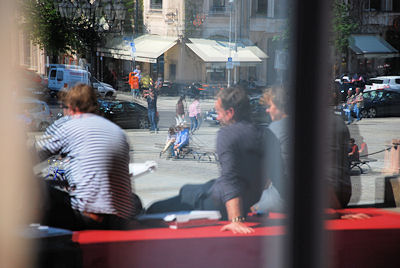 |
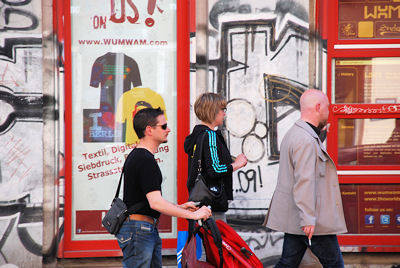 |
Finally I reach Kreuzberg. This is an ethnic rich area, full of café’s,
graffiti etc. The graffiti on the local firehouse is very nice. There
are more parks as well. At Görlitzer Park people are out in numbers,
sunbathing or making sausages on their barbecues. At the end I turn down
Cuvrystrasse with more apartments and graffiti. At the corner at
Schlesische Strasse there's a mural by Italian artist Blu and French
artist JR. From here I head for the local U-bahn-station, and returns
home.
My
evening spaziergang is in the local neighborhood, along the river Spree
– and some grocery-shopping at Edeka at the station. |
Photostory - day 6
Friday,
April 22nd
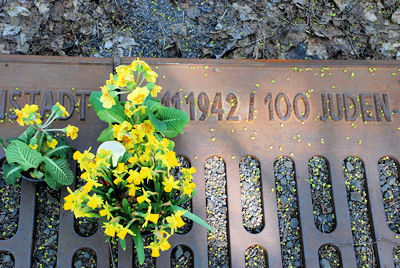 |
Another
sunny day in Berlin. I wasn’t expecting just wearing t-shirts on this trip.
This Good
Friday, I head with the S7 to Grunewald station in the western part of Berlin.
It’s a small suburb with a dramatic story. It was here the Jews were deported to
the KZ-camps in Theresienstadt, Auschwitz etc. during WW2. It all happened at
track 17 – Gleiss 17. Now it has been turned into a nice memorial. For each
deportation a metal plague is laid down, telling when, where and how many were
deported on each train. In the beginning it was about 100 with each train – but
in the spring of 1943 one train to Auschwitz had more than 1800 people on board.
|
|
From
this tragic part of history I head into the forest of Grunewald. Many
trees have just blossomed, so the place and the colors are very nice.
The goal is Teufelsberg in the center of the forest. Teufelsberg is the
highest hill in Berlin. It was made out of bricks that were brought here
from the bombings of Berlin at the end of WW2. At the top there’s a
special sight, not even mentioned in my guidebook. I have found it on an
internet-page instead. It’s an old demolished listening-station, where
the allied used to keep an ear out to what was going on, on the other
side of the curtain during the cold war. Unfortunately as I reach the
place there’s a closed gate at the entrance. No admittance for visitors.
But – a nice guy from inside shows up. Of course – this is Berlin – so a
few people have decided to move in, and they are happy to let you in for
a small fee for the “spendekasse” for their small community. And if
“Security” shows up, you just have to tell them that you are a friend of
the place. |
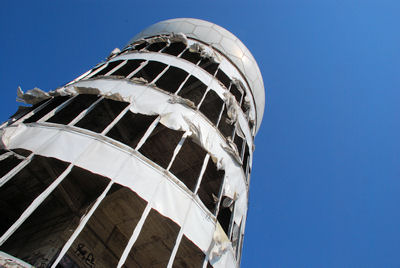
|
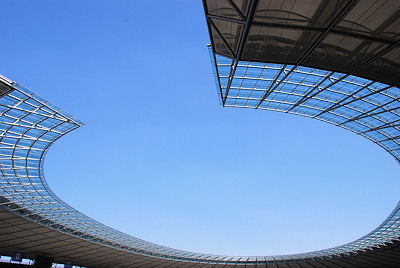 |
It’s
a fantastic place if you fancy things like this. It’s a ruin of a
listening-station with graffiti all over, and a great view on the top.
There are only 3 tourists at the place. You have to take a little care,
because there are no fences or other things making the place safe. And
do look around where you put your feet – there might be a deep hole. And
the sound of the place is magic. The wind blowing in the metal plates of
the buildings is fabulous.
From
the top you can see across to the Berlin Olympic Stadium. That’s my next
stop. I walk down the hill, find a great pizza-place at the bottom and
then take the S-bahn one stop for the Stadium. This place has its
history as well. There are pictures at the place showing Hitler at the
opening of the Olympics in 1936. The building itself is also great. It’s
build in limestone – and build to last. The only thing that is missing
is a game of football. |
|
Then I head
back to the station, and take my train back home.
A late
afternoon trip is a more common tourist-thing. 1 hour of sailing on a tour-boat
on the River Spree. It takes you past the “Washingmachine” – also known as the
Bundeskansleramt, where Angela Merkel is residing.
Photostory - day 7
Saturday,
April 23rd
I am heading
back home today. The train leaves Berlin Hauptbahnhof at 11.26 am and arrives at
Aarhus Hauptbahnhof at 6.15 pm. Das war’s
Back to frontpage |
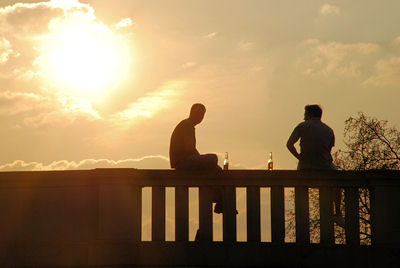 |
|















